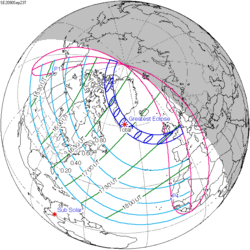| Total eclipse | |
| Gamma | 0.2167 |
|---|---|
| Magnitude | 1.0333 |
| Maximum eclipse | |
| Duration | 194 s (3 min 14 s) |
| Coordinates | 7°24′N162°48′E / 7.4°N 162.8°E |
| Max. width of band | 115 km (71 mi) |
| Times (UTC) | |
| Greatest eclipse | 1:15:23 |
| References | |
| Saros | 145 (26 of 77) |
| Catalog # (SE5000) | 9709 |
A total solar eclipse will occur at the Moon's ascending node of orbit between Monday, October 3 and Tuesday, October 4, 2089, [1] with a magnitude of 1.0333. A solar eclipse occurs when the Moon passes between Earth and the Sun, thereby totally or partly obscuring the image of the Sun for a viewer on Earth. A total solar eclipse occurs when the Moon's apparent diameter is larger than the Sun's, blocking all direct sunlight, turning day into darkness. Totality occurs in a narrow path across Earth's surface, with the partial solar eclipse visible over a surrounding region thousands of kilometres wide. Occurring about 2.3 days after perigee (on October 1, 2089, at 17:30 UTC), the Moon's apparent diameter will be larger. [2]
Contents
- Eclipse details
- Eclipse season
- Related eclipses
- Eclipses in 2089
- Metonic
- Tzolkinex
- Half-Saros
- Tritos
- Solar Saros 145
- Inex
- Triad
- Solar eclipses of 2087–2090
- Saros 145
- Metonic series
- Tritos series
- Inex series
- Notes
- References
The path of totality will be visible from parts of China, the Ryukyu Islands, the Northern Mariana Islands, and Kiribati. A partial solar eclipse will also be visible for parts of East Asia, Southeast Asia, Oceania, and Hawaii.





































































































